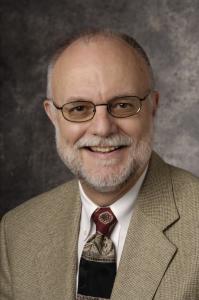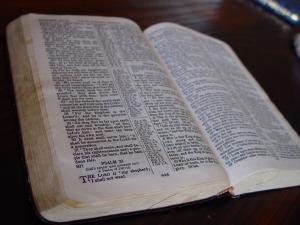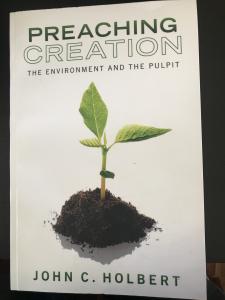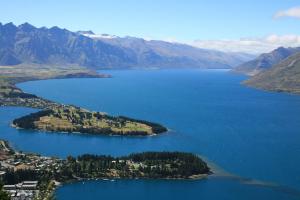 In 1999 I was asked to offer some lectures in Australia by a former colleague at Perkins School of Theology, an offer I eagerly accepted. My wife and I had never been to Australia, nor had we visited New Zealand, its relatively near neighbor “down under.” I did not know what to expect in either country, but pictures I had seen, especially of New Zealand, whetted my appetite for the trip. Because I had no reason to go to New Zealand other than pleasure, we arranged to stop there on our way to Australia. I soon discovered that New Zealand is as far from Australia as Minneapolis is from Dallas, despite how close world maps make the two countries look. It was well over a two-hour flight from Christchurch, NZ to Sydney, as I remember a rather bumpy ride over the Tasman Sea.
In 1999 I was asked to offer some lectures in Australia by a former colleague at Perkins School of Theology, an offer I eagerly accepted. My wife and I had never been to Australia, nor had we visited New Zealand, its relatively near neighbor “down under.” I did not know what to expect in either country, but pictures I had seen, especially of New Zealand, whetted my appetite for the trip. Because I had no reason to go to New Zealand other than pleasure, we arranged to stop there on our way to Australia. I soon discovered that New Zealand is as far from Australia as Minneapolis is from Dallas, despite how close world maps make the two countries look. It was well over a two-hour flight from Christchurch, NZ to Sydney, as I remember a rather bumpy ride over the Tasman Sea.
The epic movies, “The Lord of the Rings” had not yet appeared before our journey, so we were not able easily to visualize what we were about to experience in what I soon discovered is one of the world’s most breathtaking places. I had read that New Zealand encompasses some 25 of the world’s 28 climatological zones. What that means in plain English is that the place is among the most diverse on earth. For example, at one spot on the south island one finds a glacier moving its turtle-like way directly through a rain forest! Now, that is diversity! Also, in the south one can see Mt. Cook, a usually snow-capped peak, the heart of a national park, while on the north island one finds a tropical climate year round. It was nothing less than stunning nearly everywhere.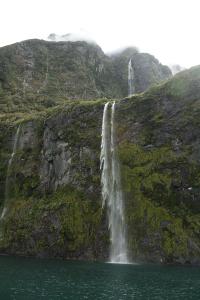
We flew to Auckland, capital of the country, located on the far northern tip of the north island, and took an hour’s flight directly to Christchurch, largest city on the south island. I had been told that Christchurch was rather like England in the 1950’s, and we found that not far from the truth. We spent some hours in a vast rose garden, trying to stay awake as long as possible before sleeping that night. The great cathedral was quite glorious, though now in some ruin due to the huge earthquake that struck the country in 2011. We rented a car (or “hired” one in the local lingo, as their English cousins say) and drove over a large part of the island from the east’s beautiful ocean views to the Mt. Cook National Park, where we stayed in the lodge with a stunning view of the famous mountain through a large window in our room. That night, I ate Emu for the first and last time, and found it, if not absolutely delicious, quite acceptable to my plebian palate.
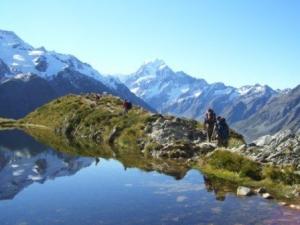 As we drove through the countryside, we noted more sheep than people, thriving in the very pleasant breezes that we were told is a near constant feature of the south island. The people were indeed warm, wonderfully friendly and helpful to these American tourists, driving on their side of the road—the left. I was very glad to have spent a year in England driving on that side; it made this trip rather calm and untroubled. We stayed a night on a farm with a lovely couple who fed us royally and offered great advice about what we should see as we went on our way.
As we drove through the countryside, we noted more sheep than people, thriving in the very pleasant breezes that we were told is a near constant feature of the south island. The people were indeed warm, wonderfully friendly and helpful to these American tourists, driving on their side of the road—the left. I was very glad to have spent a year in England driving on that side; it made this trip rather calm and untroubled. We stayed a night on a farm with a lovely couple who fed us royally and offered great advice about what we should see as we went on our way.
While we were in the country, the government made a stern announcement that no nuclear-powered ships would ever be allowed to dock in any of their ports. New Zealanders had long before rejected nuclear power as a source of any of their energy, and had focused attention mainly on renewable sources, like solar, wind, and thermal. They,
after all, had the sun, the wind, and because they rest on the Pacific’s “Ring of Fire,” the source for devastating earthquakes over the years, also have an unlimited supply of thermal energy from below ground. Thus, they have no need of nuclear energy. But there was another reason for their denial of nuclear energy in any form; they also had rejected nuclear weapons of any kind, and found any nations that relied upon them for deterrence or for first-strike capabilities nothing less than abhorrent. In this they were often led by their indigenous population, the Maoris, whose ancient ways affirmed the beauty and fecundity of the land and the deep need for unity among all peoples. It was easy to see that the amazing beauty all around them was a continuous source of a burning desire to see that beauty preserved and enhanced rather than despoiled and blighted.
Today in my local Los Angeles newspaper, there was an article about what the current Environmental Protection Agency under the “leadership” of Donald Trump and the EPA director, Scott Pruitt, has been doing during its first year in power. An independent analysis of the status of curbs on pollutants, especially from coal-fired power plants, reveals that nearly 85% of the restrictions on these plants’ pollutants have been lifted, and that the results will surely be more fouled streams, more filthy air, and more asthmatic reactions by those who have trouble breathing even in the best of times. I thought back to my time in New Zealand, now nearly 20 years before, and remembered the fabulously clean air, the pristine waters, and the stunning vistas, unclouded by pollutants. What will it take for my country to recapture that deep love of the land, that urge to protect and defend the air and the water from defilement by short-term corporate and governmental greed and/or indifference? Our environment is not merely a warehouse to be stocked and looted by us for our luxury and pleasure! It is our envelope in which we live and breathe and which we share with all other living creatures. I fear in 2018 in the USA our EPA has become the Environmental Pollutant Agency, using its authority not to defend and protect but to destroy and despoil what God has entrusted to us. Such policies can only end in disaster, as anyone who actually looks at the world can see.
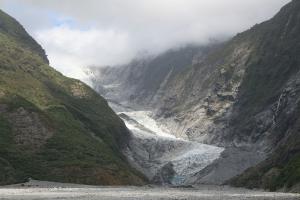 I do not mean to suggest that New Zealand is paradise on earth; it is hardly completely free of the problems that plague all of us on our shrinking and troubled planet. But I found there a peaceful place, a lovely place, a place of wonder and hope that I too often fail to find in the country of my birth. I pray that New Zealanders may enjoy many more years of beauty and peace in their land. And I further pray that those in the US who think that a quick buck outweighs long-term protections to our environment will go the way of the Dodo, a symbol of the extinction that may come for us all as we choke on our own foul excretions, rather than bask in the beauty of God’s planet earth.
I do not mean to suggest that New Zealand is paradise on earth; it is hardly completely free of the problems that plague all of us on our shrinking and troubled planet. But I found there a peaceful place, a lovely place, a place of wonder and hope that I too often fail to find in the country of my birth. I pray that New Zealanders may enjoy many more years of beauty and peace in their land. And I further pray that those in the US who think that a quick buck outweighs long-term protections to our environment will go the way of the Dodo, a symbol of the extinction that may come for us all as we choke on our own foul excretions, rather than bask in the beauty of God’s planet earth.
(Images from Wikimedia Commons)


